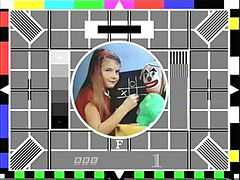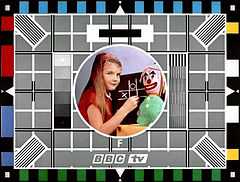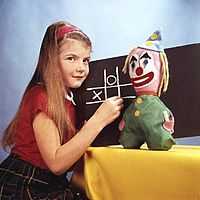Test Card F

Test Card F is a test card that was created by the BBC and used on television in the United Kingdom and in countries elsewhere in the world for more than four decades. Like other test cards, it was usually shown while no programmes were being broadcast. It was the first to be transmitted in colour in the UK and the first to feature a person,[1] and has become an iconic British image regularly subject to parody.
The central image on the card shows eight-year-old Carole Hersee (born 1958)[2] playing noughts and crosses with a clown doll, Bubbles the Clown, surrounded by various greyscales and colour test signals needed to ensure a correct picture. It was first broadcast on 2 July 1967 (the day after the first colour pictures appeared to the public on television) on BBC2.
The card was developed by a BBC engineer, George Hersee (1924-2001), father of the girl in the central image. It was frequently broadcast during downtime on BBC1 until that channel went fully 24 hours in November 1997, and on BBC Two until its downtime was replaced entirely by Pages from Ceefax in 1998, after which it was only seen during engineering work, and was last seen in this role in 1999. The card was also seen on ITV in the 1970s. Test Card J, Test Card W and Test Card X, which are digitally enhanced, widescreen and high definition versions respectively, have replaced it, although they are very infrequently broadcast because the BBC now broadcasts BBC News and promo loops of programmes shown on the channel on its terrestrial channels during downtime. Testcards now only appear during the annual RBS (rebroadcast standby) Test Transmissions and, until 2013, during the BBC HD preview loop, which used Test Card X.
Technical information
Virtually all the designs and patterns on the card have some significance. Along the top (see above) are 95% colour-bars in descending order of luminance - white, yellow, cyan, green, magenta, red, blue and black. There are triangles on each of the four sides of the card to check for correct overscanning of the picture. Standard greyscale and frequency response tests are found on the left and right respectively of the central picture. On the updated Test Card J, the X on the noughts-and-crosses board is an indicator for aligning the centre of the screen.

The blocks of colour on the sides would cause the picture to tear horizontally if the sync circuits were not adjusted properly. The closely spaced lines in various parts of the screen allowed focus to be checked from centre to edge; mistuning would also blur the lines. All parts of the greyscale would not be distinct if contrast and brightness (both internal preset settings and user adjustments) were not set correctly. The black bar on a white background revealed ringing and signal reflections. The castellations along the top and bottom also revealed possible setup problems.
A child was depicted so that wrong skin colour would be obvious and not subject to changing make-up fashions. The juxtaposed garish colours of the clown were such that a common transmission error called chrominance/luminance delay inequality would make the clown's yellow buttons turn white.
Modern circuitry using large-scale integration is much less susceptible to most of these problems. Some of them are also associated with cathode ray tubes; liquid crystal displays (LCDs), that are not scanned at high speed, also help. The test card was a vital tool in its day, but has become far less important.
The name of the broadcasting channel usually appeared in the space underneath the letter F — a sans-serif F denoting an original optical version of the test card.
Originally, Test Card F was a photographic slide made up of two transparencies in perfect registration—one containing the colour information and the other the monochrome background. The card was converted to electronic form in 1984 when electronic storage became possible.
Test Card F music
A sound of some kind is usually transmitted in the background. It is sometimes music, usually a composition commissioned by the station itself or "royalty-free" stock music. Composers whose music has been used include Roger Roger, Johnny Pearson, Neil Richardson and Frank Chacksfield.
However, during more recent years in which the Test Card is only played during engineering tests on the BBC, it is more common to hear a steady tone of various pitches accompanied by a female talking clock. Test Card music had ceased to be frequently heard in the 1980s (though it continued to be played over Pages From Ceefax until the termination of that service on 23 October 2012).
Bubbles the Clown

Along with his Test Card F co-star Carole Hersee, Bubbles has appeared for an estimated total of 70,000 hours[3] on television, equivalent to nearly eight whole years, which is more than any living person other than Carole (who still owns Bubbles).[4]
Colour
Bubbles' original body colour was blue and white, but the BBC engineers decided that green was also needed within the scene[5] as the other two television primary colours, red and blue, were already shown. A green wrap was made to cover his body and this can be seen in Test Cards J and W, along with more of his body shown in the photograph[6] — revealing the fact that he is actually holding a piece of chalk, which was not previously visible.
However, the shade of green material chosen was too subtle for the engineers' liking and so Bubbles' body colour in Test Card F was retouched (this can be seen from the edges of his image) to make it more saturated and also to give it a higher luminance value on screen.[5]
Recent years
Since the late 1990s, Bubbles has only very rarely appeared on television as Test Card F has been discontinued, and Test Cards J and W are very seldom shown due to the advent of digital television and 24-hour programming.[6]
For the fortieth anniversary of Test Card F, there has been renewed interest in Bubbles in the media; in a 2007 interview, Hersee mentioned that she took Bubbles into school with her to prove to her headmaster that she really was the girl in the picture.[7]
The BBC Web site (as of June 2009) features Bubbles next to a blackboard with '404' inscribed on it when a user visits a page that does not exist. (BBC Website 404 Page)
The BBC website's '500' Internal Error page features Bubbles next to a blackboard but with fire in the background.
In popular culture
Variations and parodies of Test Card F are common in British broadcasting, Internet sites and games.
Television
- In the 1970s ITV satirical series, End of Part One, there is an audition for a new test card 'girl'. This features various adults (including a bearded man) sitting behind a giant test-card cutout and attempting the same pose as Test Card F.
- A fictional version of Test Card F, of sorts, appears in the BBC television series Life on Mars. A girl resembling Carole Hersee as she appeared in the test card acts as a sort of spiritual guide in the series. The real thing flashes on and off during a BBC One ident in order to create the feeling of the 1970s.
- The Weebl and Bob cartoon "merchandise" features a parody of Test Card F, in which Carole is replaced by Weebl and the clown is replaced by Bob wearing a clown's hat and makeup.
- A BBC2 Sting shown from 1993 to 1997 showed a girl acting as Carole Hersee replacing Bubbles The Clown with a logo "2" made of strings next to the blackboard.
- A version of Test Card F (with Carole replaced) was seen in 2006 on Channel M as part of the Frank Sidebottom show.
- In a Headcases sketch, Katie Price is shown as Hersee, while a made-up Peter Andre is the doll Bubbles.
- ITV Digital, the former UK pay-TV platform, featured Al (Johnny Vegas) and Monkey as the girl and clown on its spoof testcard, shown when some of the channels on the platform were off air.[8]
- An updated version of Test Card F has appeared on Sky HD, with television presenter Myleene Klass playing the role of Carole Hersee. Unlike the original static Test Card F, Klass steps out of the frame and gives viewers a ten-minute guide to high-definition television.[1]
- Julian Barratt and Noel Fielding of BBC Three's cult comedy programme The Mighty Boosh posed for a parody of Test Card F for Guardian Unlimited in 2006.
- Nick UK showed a parody of Test Card F during off-time circa 1997, using Test Card N. It features a big Nick splat logo in the center, and pictures of stars (like Tommy from Rugrats, or Stimpy from Ren & Stimpy) on other areas.
- The celebrity quiz show "It's Only TV, But I Like It" used a version of the test card replacing the scene with the host Jonathan Ross and regular team captains Julian Clary and Phill Jupitus surrounding the chalkboard as a promotional image.
- The S.T.A.L.K.E.R.: Clear Sky episode of the show Zero Punctuation uses a similar image, with the girl replaced by Yahtzee and the clown replaced by an imp.
- It was spoofed in an episode of Spitting Image which featured Bubbles complaining about the music being played, then going on strike, with Nicholas Witchell bought in as a replacement, much to Carole's dismay.
- In the sketch show That Mitchell and Webb Look, there is a series of sketches portraying the aftermath of "The Event" which feature a parody of Test Card F, featuring Bubbles with a sad face, Carole wearing a gas mask, and depressing phrases such as "Mummy won't wake up" written on the blackboard.
- The ominous "Poetry Girl" appears in a frame with a pattern very similar to that of Test Card F in the 2010 Doctor Who episode, "The Beast Below".
- The Fonejacker life insurance[9] sketch features Test Card F on the screen of an ECG machine.
- In the credits of Gravity Falls. Grunkle Stan parodys Test Card F replacing the image of Carole Hersee.
- During the last appearance of Otis the Aardvark on CBBC, Otis appeared in Test Card F frame, finishing the Noughts and Crosses puzzle on the blackboard.
- In one episode of the CBBC Saturday Morning show Live & Kicking, Jamie Theakston told the viewers that messing with the controls of the BBC studio could cause them to go off air. Upon hearing this, Mr Blobby smacked down on them, and caused the image to come up, although with it being labeled B (as in Blobby) and with Mr Blobby replacing Carole.
Other
- The image has appeared on recordings of easy listening music played during transmissions: The Girl, The Doll, The Music and Big Bandwidth, both released by Chandos Records.
- A long-standing urban myth claims that the card inspired the lyrics of the Jimi Hendrix Experience song The Wind Cries Mary. This is incorrect, and in fact the song was released before the creation of Card F.
- A parody of the card can be accessible from the Extras menu of the videogame MotorStorm, but with the girl changed to a Motocross rider.
- In Fable II, a parody of the card is found in the video option screen.
- Roger Mellie of Viz magazine fame appeared in the introductory frame of one of his cartoons as a substitute for Carole Hersee. Instead of playing noughts and crosses, he has written "Bollocks" on the blackboard.
- Sun television columnist Ally Ross uses a parody of Test Card F, replacing Carole Hersee with himself, the blackboard text always referencing an event from that weeks popular TV programmes.
- On the Cracking Contraptions episode "The Tellyscope", the test card appears, but it is nicknamed Test Card "W&G", and Bubbles and Carole are replaced by Shaun and Wallace.
- Bubbles is often seen as an evil clown, inciting phobia in some young children who witnessed him,[3] and is described as "somewhat unsettling".[3] Dorian Lynskey of The Guardian notes of a spoof of the clown's style:
| “ | Any small child catching sight of Noel Fielding of The Mighty Boosh in his clown gear would vow never to go to the circus again.[10] | ” |
- The test card is parodied in the music video for "(Waiting For) The Ghost Train" by Madness, replacing Hersee with a band member, Chas Smash, in drag and replacing the "BBC TV" logo with the text "MAD 1 COLOUR" (with a similar look to the BBC logo).[11]
- A parody of Test Card F appears numerous times in the music video of Moving to New York by the band The Wombats. Carole Hersee is replaced by images of the band in various poses.
- In 2000 a sketch group called The Benders parody Test Card F in a short film sequence where Carole Hersee is kidnapped by a hooded figure and taken round various locations in a wheelbarrow before meeting with a sad demise.
- Portishead have used the image as a backdrop or introductory images at live performances.
- At the end of the Shrek 4-D pre-show, the monitor screen shows Lord Farquaad replacing the image of Carole Hersee with himself.
See also
References
- ↑ 1.0 1.1 "Revamped testcard gets a touch of Klass". Daily Mail. 22 May 2007. Retrieved 10 June 2013.
- ↑ Prigg, Mark (5 January 2009). "Do adjust your sets: 10 years on, the 'Carole and clown' test card is back". Daily Mail. Retrieved 10 June 2013.
- ↑ 3.0 3.1 3.2 "Test card special". BBC News. 19 April 2001. Retrieved 10 June 2013.
- ↑ Deacon, Michael (25 May 2007). "Talking about the Test Card". The Telegraph. Retrieved 10 June 2013.
- ↑ 5.0 5.1 Grant, Dave. "Test Card ‘F’". The Test Card Gallery. Retrieved 10 June 2013.
- ↑ 6.0 6.1 Meldrum, Darren. "BBC Test Cards". MHP The Test Card Gallery. Retrieved 10 June 2013.
- ↑ Personal Column: Test-card special The Independent.
- ↑ Johnny Vegas: Veteran Newcomer. BBC News
- ↑ Fonejacker Life Insurance sketch
- ↑ The mighty clowns. Noel Fielding and Julian Barratt's BBC test card. Dorian Lynskey, Saturday September 9, 2006 The Guardian.
- ↑ Madness - Ghost Train music video on YouTube - first seen at 10 seconds into the video introduction
External links
BBC links
- Test card special (BBC News, 19 April 2001)
- Down-loadable test card wallpaper from the BBC
Interviews
- Carole Hersee interview marking the 40th anniversary of test card F
- Interview about the Mighty Boosh's Test Card F parody
Others
- The Test Card Circle Fan group site includes history of the BBC and ITA Test Cards, the music, and details about the Trade Test Colour Films shown from the late fifties to 1973.
- A history of the card
- A history of the BBC's test cards
| |||||||||||||||||||||||